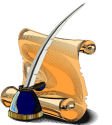Recently, some of these records (previously available on microfilm) were scanned and made available on the service Footnote. com; we are in the process of finding and retrieving these records on Warwick's men (who mostly served with Col. Hathorn's regiment), because they give details on the individuals, their families, and acquantences, that were otherwise unrecorded. They also give details on what exactly Hathorn's men were up to during the war. Hardcopy of these will be made available at the library.
In the meantime, here is one transcribed example. Azariah Ketchum's house on Church St. is now a museum of the Historical Society of the Town of Warwick. He was the master carpenter for the Old School Baptist Meeting house.
National Archives Publication No. M804 Pension No. 16,316
Transcribed by S. Gardner, 2007
State of New York
Orange County
On this fourth day of December 1832 personally appeared in open court before the Judges of the Court of Common Pleas of the said County (being a Court of ?) now sitting Azariah Ketchum of Warwick Orange county and said State aged seventy seven years, who being fist duly sworn according to law, doth on his Oath, make the following Declaration, in order to obtain the benefit of the Act of Congress passed June 7, 1832. That he entered the service of the United States, under the following named officers, and serviced as herein stated.

Deponent saith that he was born in Bedford in West Chester County, in said State, on the 18th day of February in the year 1755, as he believes, and as he has often read the same in his father’s family Record. That deponent was living in said town of Warwick where he first entered the services of the United States. Saith that in the month of April as he believes, in the year 1776, he volunteered in the company of Militia commanded by Captain John Wisner, Asa? Wisner being Ensign and belonging to Colonel John Hathorn’s Regiment, and as a corporal in the said company, was mustered for one month; was marched to fort Constitution on the side the Hudson River, where his company was attached to or commanded by Colonel Newkirk; at this place deponent was employed with his company in building said Fort, up to the end of the month, Deponent further saith that he volunteered and served two months at Fort Montgomery, in the same summer (1776) under Captain John Minthorn, Lieutenant Nathaniel Ketchum & George Vance—his Regiment commanded by Colonel John Hathorn. Deponent further saith that in the same Year he was a volunteer in the company of Captain William Blain in Colonel Nicoll’s regiment and served one month at White Plains—saith that he was in the Battle and fought the Brittish Troops on the 28th day of October of that Year, was personally acquainted with and was there under he Orders at several times, of Generals Putnam and George Clinton. Deponent saith that in the winter of 1777 he served as corporal three months under Captain John Minthorn, laying or being stationed at Chloster near the Hudson River. During the same year deponent saith that he served as a corporal under Captain Daniel Gore at the Susquehannah out along the Indian frontier for the space of five months. Was a volunteer under the command of Captain Minthorn four months at West Point in the year 1778, and also one month at Ramapo. Was marched to and lay one month at New Windsor and Fishkill in the year 1779, being as deponent saith in the month of November. Deponent further saith that in the Year 1777 he was ordered under Lieutenant Nathaniel Ketchum and marched to New Windsor, thence to Esopus or Kingston and from thence went as an escort to continental Waggons from Boston to Easton in Pennsylvania. This service deponent believes lasted about two months. Saith that he was stationed one month at Goshen to guard the prisoners there, at the time the Notorious Claudius Smith and his band were executed. Deponent further saith the he served as Corporal aforesaid under Captain John Minthorn two months at different times on the Minisink frontier. Also under the same Captain and in Colonel John Hathorn’s Regiment deponent served three months at other periods at Haverstraw and West Point. Beside frequent excursions which he performed with his fellow soldiers in arms in ?illegible word? the depredations of the Tories who haunted and robbed the Wig inhabitations along the River towns. Deponent declares that the whole time which he faithfully served his country in the Revolutionary War and in the capacity of corporal in the Militia, amounted to more than two Years. Saith he, deponent, never received any written discharge from the service. Deponent further saith that he is acquainted with John C. Murphy, a clergyman who resided in his neighborhood and who will testify as to his belief of his having been a solder of the Revolution ?known? from general reputation as to his credibility. He hereby relinquishes every claim whatever to a pension or annuity except the present and declares that his name is not on the pension roll of the agency of any state.












